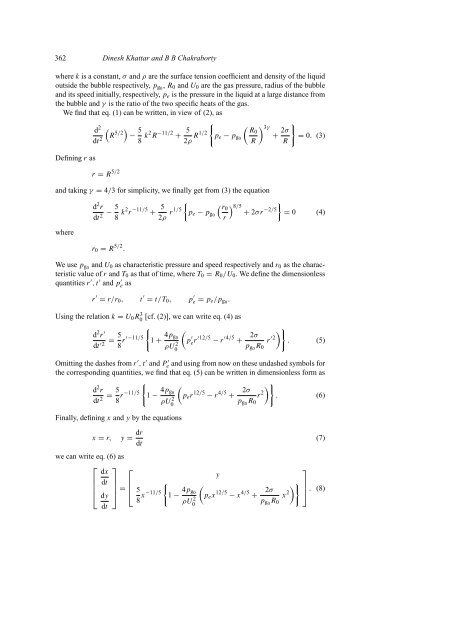Stability of a bubble expanding and translating through an inviscid ...
Stability of a bubble expanding and translating through an inviscid ...
Stability of a bubble expanding and translating through an inviscid ...
You also want an ePaper? Increase the reach of your titles
YUMPU automatically turns print PDFs into web optimized ePapers that Google loves.
362 Dinesh Khattar <strong><strong>an</strong>d</strong> B B Chakraborty<br />
where k is a const<strong>an</strong>t, σ <strong><strong>an</strong>d</strong> ρ are the surface tension coefficient <strong><strong>an</strong>d</strong> density <strong>of</strong> the liquid<br />
outside the <strong>bubble</strong> respectively, p g0 , R 0 <strong><strong>an</strong>d</strong> U 0 are the gas pressure, radius <strong>of</strong> the <strong>bubble</strong><br />
<strong><strong>an</strong>d</strong> its speed initially, respectively, p e is the pressure in the liquid at a large dist<strong>an</strong>ce from<br />
the <strong>bubble</strong> <strong><strong>an</strong>d</strong> γ is the ratio <strong>of</strong> the two specific heats <strong>of</strong> the gas.<br />
We find that eq. (1) c<strong>an</strong> be written, in view <strong>of</strong> (2), as<br />
{<br />
d 2 (<br />
dt 2 R 5/2) − 5 8 k2 R −11/2 + 5<br />
( ) }<br />
3γ R0<br />
2ρ R1/2 p e − p g0 + 2σ = 0. (3)<br />
R R<br />
Defining r as<br />
r = R 5/2<br />
<strong><strong>an</strong>d</strong> taking γ = 4/3 for simplicity, we finally get from (3) the equation<br />
d 2 r<br />
dt 2 − 5 8 k2 r −11/5 + 5 { ( r0<br />
) 8/5<br />
2ρ r1/5 p e − p g0 + 2σr<br />
−2/5}<br />
= 0 (4)<br />
r<br />
where<br />
r 0 = R 5/2 .<br />
We use p g0 <strong><strong>an</strong>d</strong> U 0 as characteristic pressure <strong><strong>an</strong>d</strong> speed respectively <strong><strong>an</strong>d</strong> r 0 as the characteristic<br />
value <strong>of</strong> r <strong><strong>an</strong>d</strong> T 0 as that <strong>of</strong> time, where T 0 = R 0 /U 0 . We define the dimensionless<br />
qu<strong>an</strong>tities r ′ ,t ′ <strong><strong>an</strong>d</strong> p ′ e as<br />
r ′ = r/r 0 , t ′ = t/T 0 , p ′ e = p e/p g0 .<br />
Using the relation k = U 0 R0 3 [cf. (2)], we c<strong>an</strong> write eq. (4) as<br />
{<br />
d 2 r ′<br />
dt ′2 = 5 8 r′−11/5 1 + 4p (<br />
g 0<br />
ρU0<br />
2 p e ′ r′12/5 − r ′4/5 +<br />
2σ ) }<br />
r ′2 . (5)<br />
p g0 R 0<br />
Omitting the dashes from r ′ ,t ′ <strong><strong>an</strong>d</strong> P e ′ <strong><strong>an</strong>d</strong> using from now on these undashed symbols for<br />
the corresponding qu<strong>an</strong>tities, we find that eq. (5) c<strong>an</strong> be written in dimensionless form as<br />
{<br />
d 2 r<br />
dt 2 = 5 8 r−11/5 1 − 4p (<br />
g 0<br />
ρU0<br />
2 p e r 12/5 − r 4/5 +<br />
2σ ) }<br />
r 2 . (6)<br />
p g0 R 0<br />
Finally, defining x <strong><strong>an</strong>d</strong> y by the equations<br />
x = r, y = dr<br />
dt<br />
we c<strong>an</strong> write eq. (6) as<br />
⎡<br />
⎢<br />
⎣<br />
dx<br />
dt<br />
dy<br />
dt<br />
⎤ ⎡<br />
⎥<br />
⎦ = ⎢<br />
⎣<br />
y<br />
{<br />
5<br />
8 x−11/5 1 − 4p (<br />
g 0<br />
ρU0<br />
2 p e x 12/5 − x 4/5 +<br />
(7)<br />
⎤<br />
2σ ) } ⎥<br />
x 2 ⎦ . (8)<br />
p g0 R 0
















